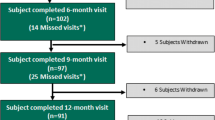Abstract
We aimed to compare the effectiveness of bilateral and unilateral block application in chronic migraine patients and whether there were differences in their effectiveness retrospectively. In chronic migraine patients undergoing Greater occipital nerve (GON) block, mean number of days with pain per month before and after block, mean duration of pain in attacks (in hours), and mean Visual Analog Scale (VAS) in attack and pain severity were recorded from files. The patients underwent one block a week for the first 1 month, thereafter one block a month according to GON block protocol used by our institute. Of 41 patients included in the study, 23 underwent unilateral block (group 1) and 18 underwent bilateral block (group 2). In both groups, number of days with migraine decreased significantly in 2 and 3 months as compared to pre-block treatment (P < 0.001). Mean duration of headache decreased in group 2 during treatment (P < 0.001). In group 1, mean duration of headache also decreased but did not differ significantly (P = 0.051). Mean severity of migraine decreased significantly differ in group 1 in 2, 3 months as compared to pre-block treatment (P < 0.001). No differences were observed in frequency, severity and duration of headache between groups during 3-month treatment period. GON block is effective in chronic migraine and bilateral application is no superior over unilateral application.
Similar content being viewed by others
References
Stewart WF, Wood C, Reed ML et al (2008) Cumulative lifetime migraine incidence in women and men. Cephalalgia 28:1170–1178
Buse DC, Manack AN, Fanning KM et al (2012) Chronic migraine prevalence, disability, and sociodemographic factors: results from the American Migraine Prevalence and Prevention Study. Headache 52:1456–1470
Blumenfeld AM, Bloudek LM, Becker WJ et al (2013) Patterns of use and reasons for discontinuation of prophylactic medications for episodic migraine and chronic migraine: results from the second international burden of migraine study (IBMS-II). Headache 53:644–655
Blumenfeld A, Ashkenazi A, Grosberg B et al (2010) Patterns of use of peripheral nerve blocks and trigger point injections among headache practitioners in the USA: results of the American Headache Society Interventional Procedure Survey (AHS-IPS). Headache 50:937–942
Inan LE, Inan N, Karadaş Ö et al (2015) Greater occipital nerve blockade for the treatment of chronic migraine: a randomized, multicenter, double-blind, and placebo-controlled study. Acta Neurol Scand 132:270–277
Palamar D, Uluduz D, Saip S, Erden G, Unalan H, Akarırmak U (2015) Ultrasound-guided greater occipital nerve block: an efficient technique in chronic refractory migraine without aura? Pain Phys 18:153–162
Blumfeld A, Ashkenazi A, Napcahan U et al (2013) Expert consensus recommendations for the performance of peripheral nerve blocks for headaches—a narrative review. Headache 53:437–446
Caputi CA, Firetto V (1997) Therapeutic blockade of greater occipital and supraorbital nerves in migraine patients. Headache 7:174–179
Young W, Cook B, Malik S, Shaw J, Oshinsky M (2005) The first 5 minutes after greater occipital nerve block. Headache 48:1126–1139
Takmaz SA, Inan N, Uçler S, Yazar MA, Inan L, Başar H (2008) Greater occipital nerve block in migraine headache: preliminary results of 10 patients. Agrı 20:47–50
Ashkenazi A, Matro R, Shaw JW, Abbas MA, Silberstein SD (2008) Greater occipital nerve block using local anesthetics alone or with triamcinolone for transformed migraine: a randomised comparative study. J Neurol Neurosurg Psychiatry 79:415–417
Tobin AJ, Flitman SS (2009) Occipital nerve blocks: effect of symptomatic medication overuse and type on failure rate. Headache 49:1479–1485
Weibelt S, Andress-Rothrock D, King W, Rothrock J (2010) Suboccipital nerve blocks for suppression of chronic migraine: safety, efficacy, and predictors of outcome. Headache 50:1041–1044
Afridi SK, Shields KG, Bhola R, Goadsby PJ (2006) Greater occipital nerve injection in primary headache syndromes—prolonged effects from a single injection. Pain 122:126–129
Dilli E, Halker R, Vargas B et al (2015) Occipital nerve block for the short-term preventive treatment of migraine: a randomized, double-blinded, placebo-controlled study. Cephalalgia 35:959–968
Bartsch T, Goadsby PJ (2002) Stimulation of the greater occipital nerve induces increased central excitability of dural afferent input. Brain 125:1496–1509
Piovesan EJ, Kowacs PA, Tatsuı CE, Lange MC, Ribas LC, Werneck LC (2001) Referred pain after painful stimulation of the greater occipital nerve in humans: evidence of convergence of cervical afferences on trigeminal nuclei. Cephalalgia 21:107–109
Busch V, Jakob W, Juergens T, Schulte-Mattler W, Kaube H, May A (2006) Functional connectivity between trigeminal and occipital nerves revealed by occipital nerve blockade and nociceptive blink reflexes. Cephalalgia 26:50–55
Young WB (2010) Blocking the greater occipital nerve: utility in headache management. Curr Pain Headche Rep 14:404–408
Author information
Authors and Affiliations
Corresponding author
Ethics declarations
Conflict of interest
None.
Rights and permissions
About this article
Cite this article
Ünal-Artık, H.A., İnan, L.E., Ataç-Uçar, C. et al. Do bilateral and unilateral greater occipital nerve block effectiveness differ in chronic migraine patients?. Neurol Sci 38, 949–954 (2017). https://doi.org/10.1007/s10072-017-2861-5
Received:
Accepted:
Published:
Issue Date:
DOI: https://doi.org/10.1007/s10072-017-2861-5




